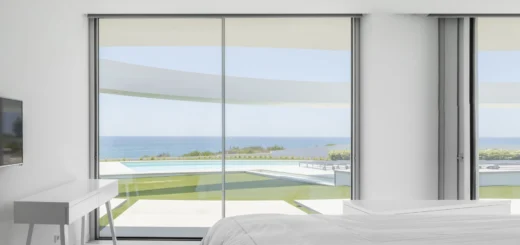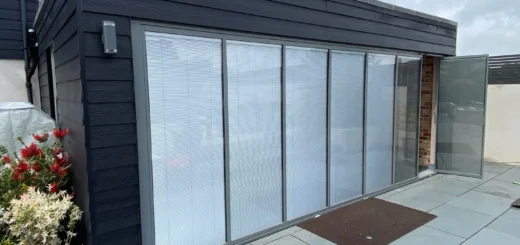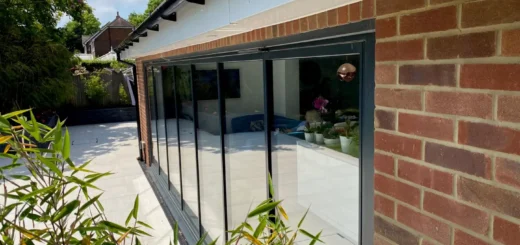Kitchen Bifold Doors: Styles, Materials and Features
Table of Contents
What Makes Bifold Doors Right for Kitchens?
Kitchen bifold doors, also known as concertina doors, offer a practical solution for connecting spaces in British homes. Unlike traditional hinged doors that swing open, these doors fold neatly against the wall in a concertina pattern, creating wide, unobstructed openings that bring fresh possibilities to your kitchen layout. Their growing popularity stems from their ability to adapt to both period properties and modern builds, while solving common kitchen design challenges.
How Kitchen Bifolding Doors Work
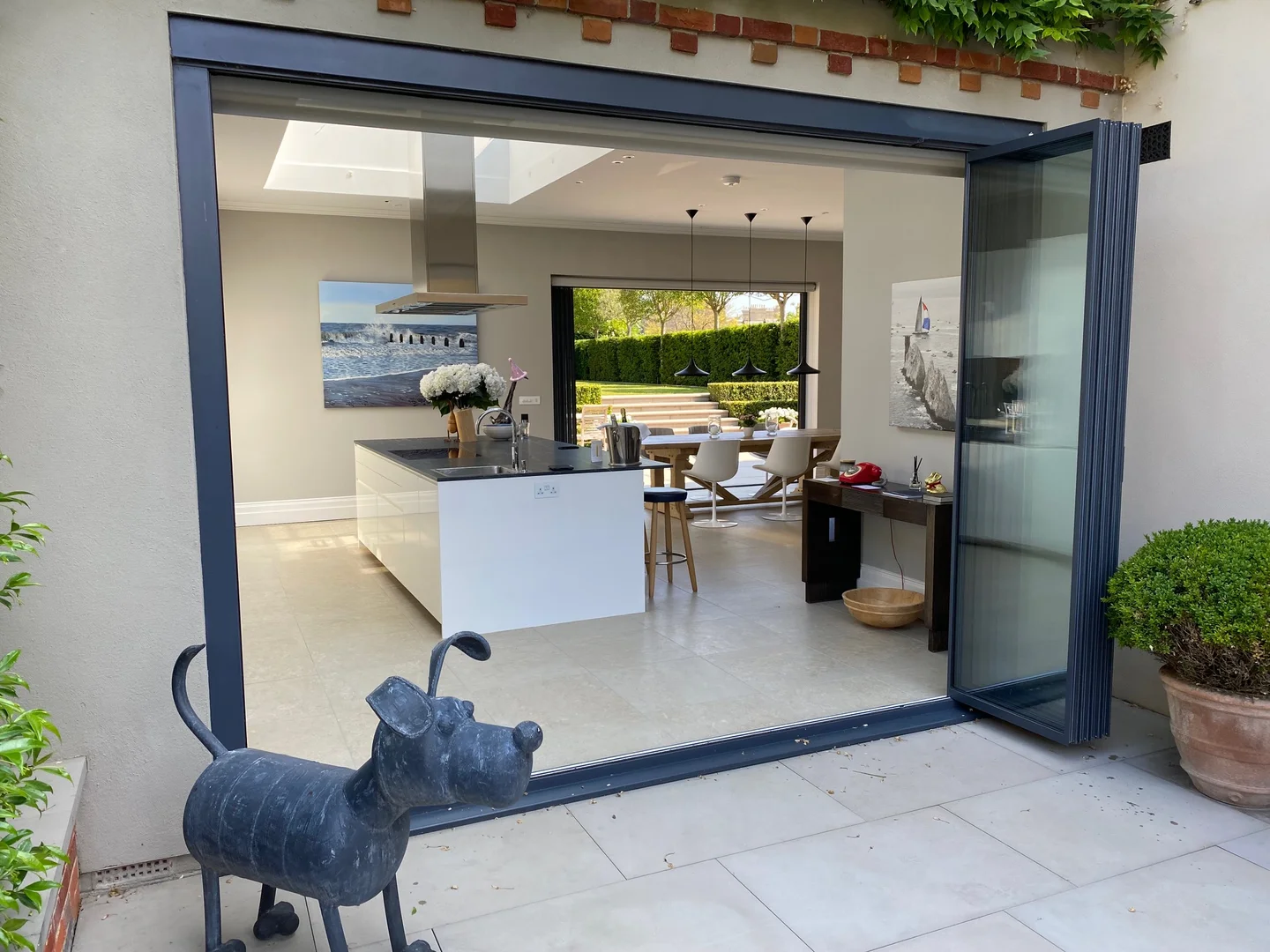
The operating mechanism of kitchen folding doors centres on a tracking system fitted either at the top or bottom of the frame. Each panel connects to its neighbour using sturdy hinges, allowing the doors to fold smoothly as they slide along the track. Modern systems typically feature a main traffic door for everyday use, while the remaining panels can be opened fully when needed. The tracking systems come in two main types: top-hung and bottom-rolling. Top-hung systems prove particularly suitable for kitchens as they prevent debris from interfering with the door operation, though they require adequate structural support above. Bottom-rolling systems offer excellent stability and work well in situations where upper structural support might be limited.
Most manufacturers offer configurations ranging from two to eight door panels. The number you choose for your kitchen bifold doors depends largely on your opening width and how you plan to use the space. For kitchen installations, odd numbers of panels often work best as they allow for a traffic door on either end. Weather-resistant seals and multi-point locking systems come standard on external doors, providing security and draught protection.
Light and Space Benefits of Bifold Kitchen Doors
Natural light floods through the broad glass panels of external bi folding doors, brightening work surfaces and creating an airy atmosphere in your kitchen. The ability to fold these doors completely to one side proves particularly valuable during summer months, when you might want to keep them open throughout the day. Double or triple glazing helps maintain comfortable temperatures year-round, while special solar control glass can reduce glare on sunny days – a useful feature when preparing food or working at kitchen counters.
British weather patterns make proper glazing important. Modern double-glazed units filled with argon gas help maintain steady kitchen temperatures throughout the year. Low-emissivity coatings reflect heat back into the room during winter while limiting solar gain in summer, helping to keep your kitchen comfortable regardless of the season.
Making the Most of Available Space
Internal bifold doors with glass help divide living spaces without creating permanent barriers. Moving from cooking to dining becomes effortless, as these doors can be partially or fully opened to suit different occasions. The flexibility to adjust the opening width makes these doors especially practical in busy family kitchens. Frame materials range from aluminium and timber to composite options, each bringing distinct benefits to kitchen settings. Aluminium frames offer slim sightlines and minimal maintenance, while timber brings natural warmth and can be painted to match your kitchen colour scheme.
Common Kitchen Uses
Kitchen bi fold doors shine in various applications throughout British homes. Many homeowners install them between kitchens and dining rooms, creating flexible living arrangements that adapt to different needs throughout the day. The doors’ ability to stack neatly against the wall proves invaluable during dinner parties or family gatherings, while their robust construction ensures reliable daily use.
Clever threshold designs make these doors particularly suited to kitchen installations. Flush floor tracks create smooth movement between spaces – ideal when carrying plates or moving between cooking and dining areas. Low-profile options work well for family homes, reducing trip hazards while maintaining good weather sealing for external doors. The latest systems feature magnetic door catches and soft-close mechanisms, adding both safety and convenience to daily operation.
Toughened safety glass often comes as standard, providing peace of mind in busy kitchen environments. Obscured or frosted glass panels offer privacy where needed, while clear glass maximises light flow. Some manufacturers offer integrated blinds sealed within the glass units, providing adjustable privacy and shade without collecting kitchen grease or requiring regular cleaning.
Creating the Perfect Open-Plan Kitchen
Installing kitchen bifold doors requires thoughtful planning that accounts for both practical requirements and visual appeal. The layout must support your daily routines while adding value to your home.
Planning Your Kitchen Layout
The positioning of kitchen bifold doors affects how smoothly you’ll move between spaces in your open-plan layout. Placing bi folding kitchen doors in line with islands or breakfast bars defines distinct zones while maintaining clear views across the space. The height and direction of door panels should prevent any obstruction near ovens, sinks, or high-traffic pathways, especially when multiple people use the kitchen at once.
Door stacking deserves proper attention – your bifold kitchen doors can fold to the left, right, or split in the middle based on your space. Appliance placement and cabinet configurations will determine where panels stack most effectively. The flow between preparation and dining spaces remains easy when panels fold away from main work areas and thoroughfares.
Choosing Door Configurations
Modern kitchen bifold doors adapt to openings of various sizes through different panel arrangements. Internal folding doors typically need fewer panels than external sets, with most internal installations using two to four panels. Larger external openings might incorporate five or more panels, creating broad access to garden spaces.
- 2-panel: Perfect between kitchen and dining spaces
- 3-panel: Allows one traffic door with good width
- 4-panel: Enables central parting
- 5+ panels: Suits garden-facing walls
Movements between kitchen zones guide where to place the main traffic door in bi-folding doors. The primary door’s location should feel natural when carrying dishes or moving between cooking and dining areas. Kitchen concertina doors with odd-numbered configurations enable traffic doors at both ends, improving daily convenience.
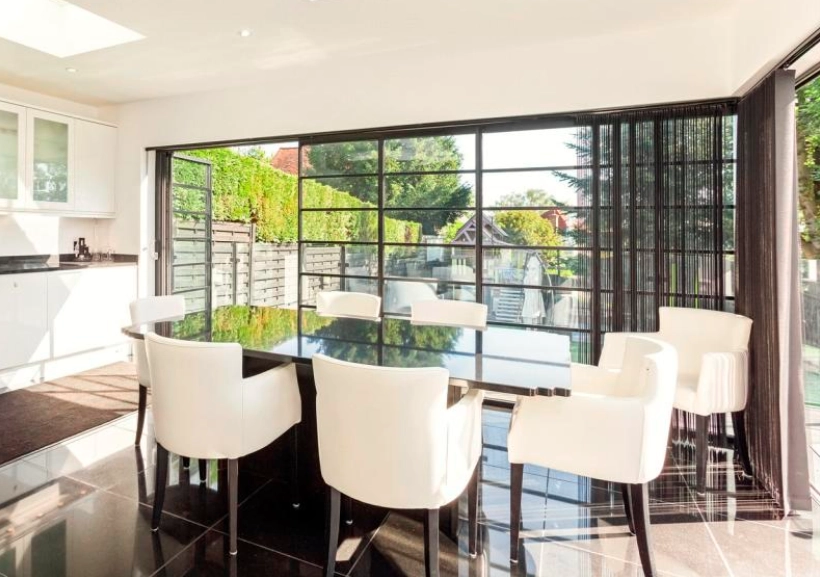
Matching Your Kitchen Style
The frames of kitchen bifold doors can match or contrast with your existing fittings, depending on your design goals. Powder-coated aluminium generally comes in hundreds of RAL options, enabling precise coordination with kitchen units.
Frame widths vary from slim modern profiles to wider traditional styles, each bringing its character to the space.
Your chosen colour palette extends beyond the frames to handles, hinges, and tracking systems. Bespoke bifold doors allow for complete customisation of these elements. Black hardware creates definition against light frames, while steel finishes complement contemporary schemes. Clean lines emerge from flush handles that sit within the frame when doors open fully.
Glass selections change how your kitchen bifold doors interact with light and space. External sets often feature clear glass to capture garden views, while internal doors might use obscured patterns for privacy between zones. Some designs mix clear and textured glass, maintaining light flow while screening certain areas from view.
Smart Solutions for Small Kitchens
Working with limited space requires clever door solutions that create a sense of openness. Kitchen bifold doors let you divide rooms without wasting precious floor area, unlike traditional swing doors that need clearance space to operate properly.
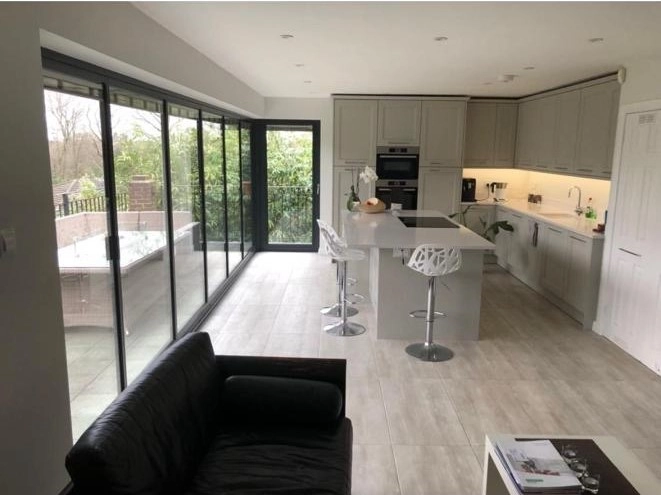
Space-Saving Door Arrangements
Kitchen folding doors with panels that stack flat against walls add valuable usable area to compact kitchens.
Unlike hinged doors, which require nearly a metre of clearance, bifolding kitchen doors fold outward into adjacent rooms rather than swinging into preparation zones. This design protects work surfaces and keeps cooking areas clear while allowing for smooth movement between spaces during busy meal preparation times.
Narrow galley layouts shine with kitchen bifold doors, as the folding mechanism prevents that boxed-in feeling common to smaller spaces. The position of tracks and runners affects both operation and space efficiency – many homeowners choose top-hung bifold door systems for their kitchens since they eliminate ground-level obstacles. When opened fully, the stacked panels occupy minimal wall space while offering the broadest possible access point between rooms.
Connecting Adjacent Rooms
Kitchen bifold doors break down barriers between spaces while maintaining the ability to separate them when needed. Strategic placement between kitchen and dining areas lets you adapt the space throughout the day – keep doors partially open during cooking to contain food aromas while maintaining conversation, then fold them completely back for family dinners or entertaining.
The placement of kitchen bifold doors in relation to work zones can improve the practicality of compact spaces. Corner installations prove particularly effective, as kitchen bifold doors can stack completely clear of throughways. Open sight lines between connected spaces help smaller kitchens feel more spacious, while still offering the flexibility to close off areas during messy food preparation.
Careful configuration of bi-fold doors makes a big difference in tight spaces. Three-panel arrangements often provide the perfect balance between width and usability for small kitchen doorways, with the central panel folding to either side based on your layout. The traffic door’s location should line up naturally with your most common paths between spaces, reducing unnecessary steps during daily kitchen tasks.
Glass choices in kitchen bifold doors influence both the feeling of space and practical usage patterns. Clear glazing keeps visual connections strong between areas, though you might want frosted sections at counter height for hiding kitchen clutter. Modern aluminium frames offer slim profiles that increase the glass area without compromising strength – essential in busy kitchen environments where doors see frequent daily use.
Panel weight and ease of operation become even more important in small kitchen bifold doors, where space constraints might affect door handling. Quality running gear ensures smooth movement even in tight spots, while soft-close mechanisms prevent panels from swinging or slamming. Multi-point locking systems add security without bulky hardware that might intrude into limited space.
Essential Features to Look For in Kitchen Bifold Doors
Kitchen bifold doors must meet specific performance standards to cope with the unique demands of busy cooking spaces. Heat, moisture, and frequent use all affect how well these doors perform over time.
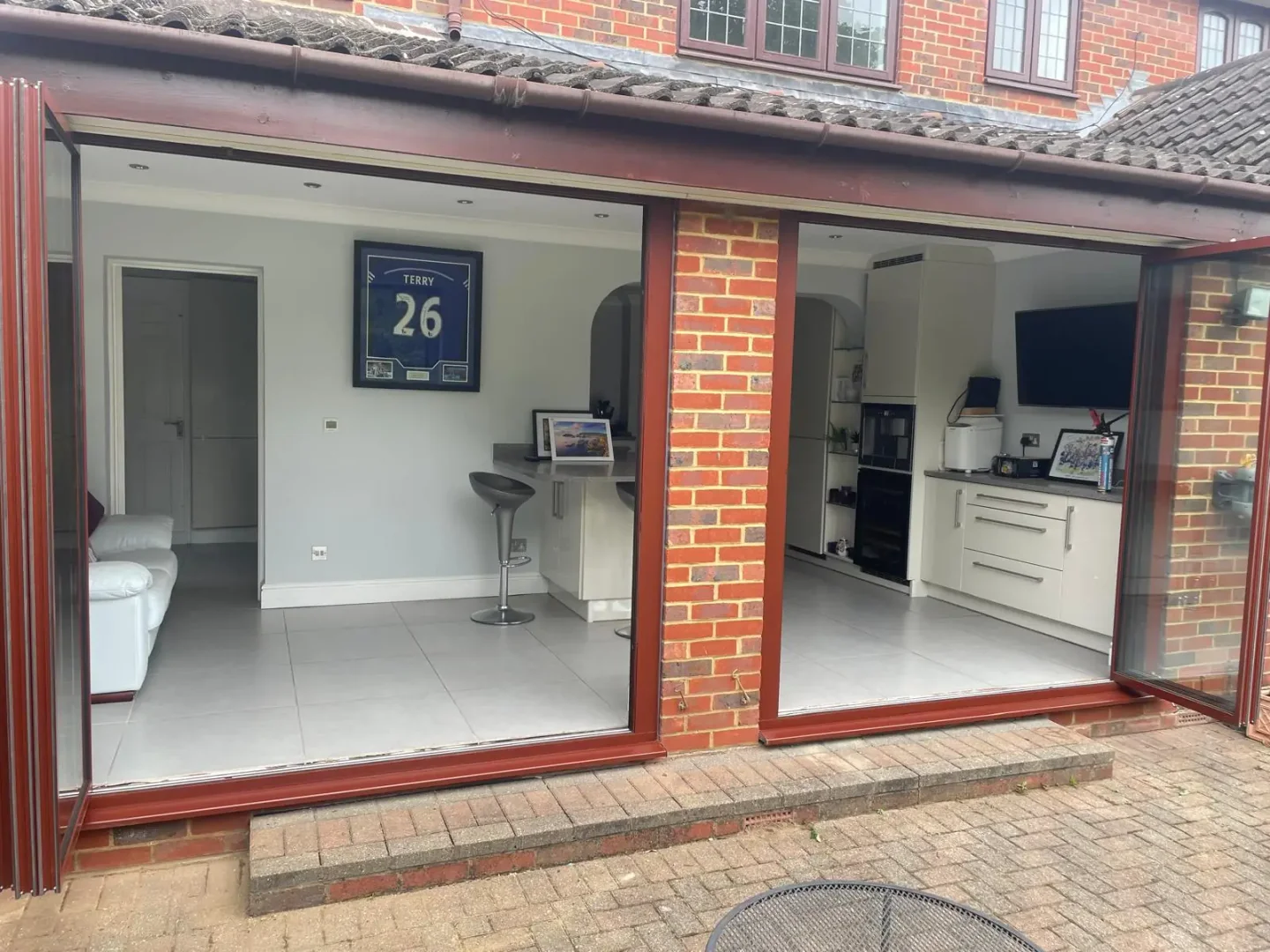
Easy Daily Access
The way kitchen bi fold doors operate makes a real difference in day-to-day use. Aluminium bifold doors often include magnetic catches that hold panels neatly in place when opened, preventing unwanted movement while carrying dishes or groceries.
The main traffic door should move freely without disturbing other panels – quality hardware makes this possible through precision engineering and robust materials.
Kitchen bifold doors need proper support through either top-hung or bottom-rolling systems. Top-hung designs keep floor tracks clear of food debris, while bottom-rolling options work well under heavy glass units. The tracks themselves should sit flush with your flooring to prevent trips. Many systems now include soft-close mechanisms on both main traffic doors and folding panels, adding safety and preventing slams.
Safety and Security
Multiple locking points along kitchen bi folding doors keep your home secure without compromising convenience. Modern systems include these security features as standard:
- Multi-point locks on main traffic doors
- Shoot bolts between door panels
- Child-safe finger guards
- Toughened safety glass
- Anti-lift mechanisms
- Key-operated locks
High-quality aluminium bi-fold doors incorporate strong frames and robust hinges that resist forced entry. The strength of aluminium allows for slimmer frames than uPVC doors while maintaining excellent security levels. Proper installation ensures gaps between panels remain consistent, preventing weak points in the locking system.
Temperature Control
Bifold patio doors must balance thermal performance with usability in kitchen settings. Modern thermal breaks within aluminium frames stop heat escaping along metal surfaces, while double-glazed panels reduce heat loss through the glass. The space between glass panes, usually filled with argon gas, helps maintain steady kitchen temperatures regardless of outdoor conditions.
Your choice of kitchen bifold doors affects both comfort and energy costs. Energy efficiency ratings indicate how well doors retain heat – better-rated systems help reduce heating bills during colder months. The glazing specification matters too, as different glass coatings can reflect heat back into the kitchen or reduce glare from strong sunlight.
UPVC doors provide good thermal insulation at lower cost than aluminium, though they require thicker frames to achieve similar strength. The frame material you pick should match your budget and performance needs. Some bifold door options combine materials, using aluminium externally for durability with uPVC internally for improved thermal properties.
Sound Reduction
Folding kitchen doors need effective sound insulation to maintain peace between cooking and living spaces. Double-glazed panels with varied glass thicknesses break up sound waves more effectively than identical panes. The seals between door panels play a key part in acoustic performance – quality gaskets compress fully when closed to block noise transmission.
Kitchen bi folding doors facing busy gardens or roads benefit from acoustic glass. This specially laminated glass dampens external noise without adding excessive weight to the door panels. The gap between glass panes also affects sound insulation – wider spaces generally perform better at reducing noise transfer.
Weather-tight seals around kitchen bifold doors serve multiple purposes beyond draught prevention. They block cooking odours from spreading through the house, contain noise from kitchen appliances, and prevent moisture migration between spaces. Quality brush seals maintain good contact even as doors age, ensuring consistent performance over many years of use.
Robust hardware supports both security and noise control in folding kitchen doors. Tight-fitting hinges and rollers prevent rattles that might develop with lesser components. Anti-rattle bumpers between panels add another layer of noise reduction, particularly valuable in family homes where doors might see heavy use throughout the day.
Design Ideas for Every Kitchen Style
Modern bifold doors bring fresh design possibilities to kitchens of every style and age. From sleek aluminium frames to period-inspired finishes, kitchen bifold doors adapt to match your home’s character while improving how you use the space.
Contemporary Kitchens
Kitchen bi fold doors with slim sightlines suit modern homes perfectly. Clean lines and minimal framework create an uncluttered look, while large glass panels draw natural light deep into cooking spaces. Matt black or anthracite grey bifold doors pair beautifully with contemporary kitchen units, creating a cohesive appearance that works in both urban and suburban settings.
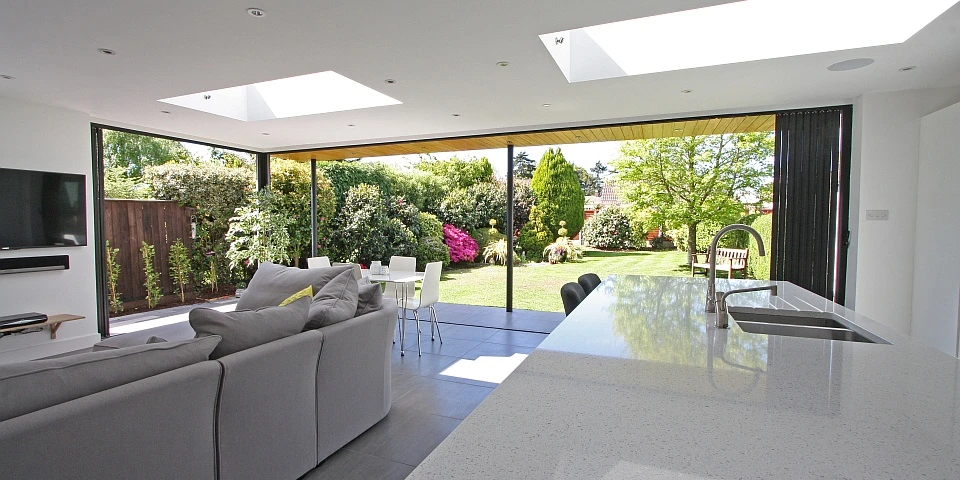
The latest kitchen bifold doors include innovative solutions for challenging spaces. Corner bi-fold doors open up two walls at once, perfect for L-shaped kitchen-diners that need better garden access. This design proves particularly effective in modern extensions, where architects often specify large glass areas to bring in maximum daylight.
Popular frame finishes for contemporary kitchens include:
- Slate grey
- Jet black
- Pure white
- Metallic silver
- Bronze
- Graphite
- Industrial black
Exterior doors demand different design approaches than internal sets. Kitchen bifold doors leading to gardens often feature larger glass panels and more substantial hardware to handle weather exposure. Many homeowners choose dark outer frames that contrast with lighter interior colours, creating visual interest while hiding inevitable marks from garden debris.
Period Properties
Traditional homes need bifold kitchen doors that complement their existing features. Panel layouts with smaller glass sections echo Georgian and Victorian glazing patterns, while frame colours can match original woodwork or metal window frames. Adding glazing bars creates authentic period character without compromising the doors’ modern performance.
Kitchen bifold doors are available in a range of sizes to allow exact matching to original apertures in older properties. Made-to-measure manufacturing ensures new doors fit perfectly within existing brick openings, maintaining proper proportions and architectural harmony. Careful attention to frame widths helps maintain the solid, substantial appearance typical of period joinery.
Practical Extras
Glass options in kitchen bifold doors affect both appearance and practicality. Sandblasted panels provide privacy while maintaining light flow, especially useful in ground-floor kitchens. Integrated blinds, sealed between glass panes, offer adjustable screening without collecting kitchen grease or moisture. These systems prove particularly valuable in south-facing rooms where glare control matters.
Handles and hinges influence both operation and aesthetics in kitchen bi fold doors. Flush handles sit neatly within door frames when folded, while magnetic catches keep panels properly aligned. Heritage-style handles in antique brass or wrought iron add authentic touches to period installations, though modern designs often favour minimal hardware in matching frame colours.
The proportions of folding kitchen doors affect their visual impact. Taller doors draw eyes upward, making ceilings appear higher, while wider panels create broader views. Split-level designs work well in kitchen extensions, where different ceiling heights need careful handling. Careful sizing of individual panels ensures easy operation while maintaining pleasing proportions.
Frame depths and profiles change how kitchen bifold doors look from different angles. Deeper frames add substance to period designs, while shallow sections suit minimal modern schemes. The junction details between panels matter too – high-quality systems feature neat, tight seams that maintain clean lines whether opened or closed.
Kitchen bifold doors work in various architectural scenarios thanks to adapatable frame designs. Slim ceiling tracks disappear into suspended ceilings, while visible hardware can become a deliberate design feature. Surface-mounted tracks offer simpler installation when working with existing structures, particularly valuable in period property renovations.
Kitchen Bifold Doors FAQ
What’s the minimum width needed for bifold doors in a kitchen?
For safety and practicality, bi folding kitchen doors generally need at least 1.8 metres of clear opening width. Most manufacturers recommend a minimum of 2 metres for comfortable daily use, though internal doors can work in slightly narrower spaces.
Can you fit bifold doors between a kitchen and dining room?
Kitchen folding doors work brilliantly between kitchen and dining spaces, offering flexibility to separate or join the rooms as needed. The ability to fold panels back completely lets you create one large space for entertaining, while closing them helps contain cooking odours and noise. Installing them between these spaces often adds value to your property and improves how you use both rooms.
Which direction should bifold doors open?
The opening direction of bifold kitchen doors depends largely on your kitchen layout and daily routines. Right-handed cooks typically prefer doors that open from right to left, while the presence of kitchen islands, cabinet runs or dining furniture might dictate the most practical stacking position. The panels should fold away from your main work zones to maintain clear access during food preparation.
Are bifold doors too modern for a Victorian kitchen?
While bifold kitchen doors feature modern mechanisms, many manufacturers offer designs that complement period properties beautifully. Traditional glazing bars, heritage hardware finishes and considered frame proportions help these doors sit comfortably in Victorian homes. Quality systems can actually improve the authenticity of period properties by referencing original architectural details.
What’s the best frame colour for kitchen bifold doors?
The ideal frame colour for kitchen concertina doors depends on both your kitchen style and the amount of natural light available. Dark anthracite grey has become a popular choice for modern kitchens, while cream or white frames suit traditional spaces and help reflect light in darker rooms. The frame colour should work with your kitchen units, window frames and overall colour scheme to create a cohesive look.
What’s the best threshold option for kitchen access?
A flush threshold usually works best for bifold kitchen doors, allowing smooth movement between spaces without creating trip hazards. The track system sits level with your flooring, making it safer when carrying hot dishes or moving between kitchen zones. Weather-rated flush thresholds for external doors provide excellent water protection while maintaining easy access.
Are aluminium frames better than uPVC for kitchens?
Bifold kitchen doors made from aluminium typically outperform uPVC in several key areas. Their strength allows for slimmer frames and larger glass panels, while their resistance to temperature changes prevents warping in hot, steamy kitchen environments.
The main drawback is cost – aluminium systems usually cost more than uPVC, though they tend to last longer and require less maintenance over time.
About SunSeeker Doors
With over 20 years of experience, SunSeeker Doors remains at the forefront of door design with our quality-tested patio doors and related products, including the bespoke UltraSlim aluminium slide and pivot door system, Frameless Glass Doors, and Slimline Sliding Glass Doors. All of our doors are suitable for both internal and external use.
To request a free quotation, please use our online form. You may also contact 01582 492730, or email info@sunseekerdoors.co.uk if you have any questions.


